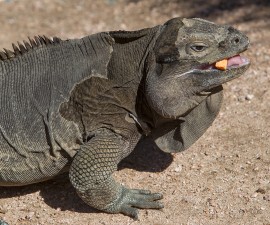It is commonly known that giant pandas eat a diet that consists almost entirely of bamboo, a very abrasive grass, as their primary source of nutrition. Pandas can spend up to 12 hours a day eating bamboo, and this can be very tough on a panda’s teeth. Gao Gao (pronounced Gow Gow), a male panda living at the San Diego Zoo, is estimated to be around 25 years old—and because he has worn teeth due to his age, this makes it difficult for him to chew the abrasive bamboo stalks. To provide him the opportunity for optimum health and make his mealtimes a little easier, Zoo nutritionists and keepers have developed a special bread for Gao Gao, made from bamboo leaves.
The process to make the bread seems basic, but it is long and requires many hours—and many hands. There are volunteers who give their time to strip leaves from the stalks of bamboo. There is a research associate in the San Diego Zoo’s nutritional services department who dries and grinds the leaves. And then there are the keepers who mix the leaves with primate biscuits and steam the specialty bread every day for Gao Gao.
“Baking bamboo bread daily for Gao Gao is time-consuming, but a labor of love for all of us who work with him,” stated Jennifer Becerra, senior mammal keeper, San Diego Zoo. “It is important for Gao Gao to eat his bamboo, keeping him healthy and satiated, and the bread provides him an easy way to consume this staple of his diet.”
Gao Gao receives three meals a day. In addition to the bamboo bread, his meals consist of cracked bamboo stalks, sliced sweet potatoes, primate biscuits and sliced apples, sometimes drizzled with his favorite treat of honey.
Gao Gao and the Zoo’s two other pandas, 24-year-old female Bai Yun (pronounced By Yoon), and their 3-year-old son Xiao Liwu (pronounced Sshyaoww Lee Woo), can be seen at their Panda Trek habitat, consisting of large exhibit areas with trees, climbing structures and off-exhibit air-conditioned bedrooms. With the recent unusually warm weather, the senior Gao Gao has preferred to spend much of his time in his cool bedroom. Panda fans also may watch the pandas on the Zoo’s Panda Cam at sandiegozoo.org/pandacam.
The San Diego Zoo’s giant pandas are on a research loan from the People’s Republic of China. As part of this long-term program, the Zoo is also collaborating with the Chinese Academy of Science in studies of behavior, ecology, genetics and conservation of wild pandas living in the Foping Nature Reserve.
Only 1,600 giant pandas are believed to exist in the wild. The animals’ reliance on bamboo leaves pandas vulnerable to any loss of their habitat—currently the major threat to their survival in the wild. San Diego Zoo Global, in conjunction with Chinese panda experts, continues to work on science-based panda conservation programs.
Bringing species back from the brink of extinction is the goal of San Diego Zoo Global. As a leader in conservation, the work of San Diego Zoo Global includes on-site wildlife conservation efforts (representing both plants and animals) at the San Diego Zoo, San Diego Zoo Safari Park, and San Diego Zoo Institute for Conservation Research, as well as international field programs on six continents. The work of these entities is inspiring children through the San Diego Zoo Kids network, reaching out through the Internet and in children’s hospitals nationwide. The work of San Diego Zoo Global is made possible by the San Diego Zoo Global Wildlife Conservancy and is supported in part by the Foundation of San Diego Zoo Global.
CONTACT: SAN DIEGO ZOO GLOBAL PUBLIC RELATIONS, 619-685-3291





